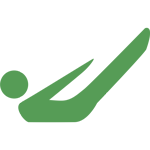Tutorial #6005
Improve Hip Flexibility/Strength
Description
About This Video
Transcript
Read Full Transcript
Hello everybody. My name is Niedra, and I had a hip replacement four months ago. This tutorial on hip mobility and strength is a series of exercises I did before surgery to keep myself flexible and mobile and after surgery as my rehab. And I am still doing these exercises, and I hope you benefit enormously from them to increase range of motion and stay strong. So very important is to strengthen your external hip, external rotators, your deep rotators.
There are series of small muscles down here that are turned off very extensively, in people, they're kind of lazy, and you want them part of the game plan for healthy hips. They deal with external rotation. So our first movement is clams. You will have your feet, buttocks, shoulder, and head in one line. And lifting and lowering the knee, For some of you, the knee will fly right up.
For some of you, it will be more stiff. So what are you looking for? You're looking for the pelvis to be very stable. So you will do more reps than I'm doing right now, but once you get into the range, then hold it and press it. So you really, really connecting with those muscles. I'm going to do the same on the other side and a little trick to make sure that you are not, rolling because it's very common for the pelvis to roll and you're not to work the bone in the socket.
Is you want these two bones stacked and then put your hand, snuggle them right up against them, and lean into your arm. And your arm will act as your teacher, and you will be able to focus and keep yourself from rolling off that plumb line, which is really where you isolate the muscles from. And then don't forget to hold the leg at the end Maybe up to thirty seconds or longer, you really want to fatigue the muscles because what happens with muscles is they turn off. They go into retirement and you have to kind of stress them to bring them up and bring them back into, the workforce of your body. Next one is the same premise, notice my toes are together, and I am lifting one knee up and no rotation at all in the pelvis.
None of this. Well, after you figure it out, you can add lifting. Now watch because this will happen almost all the time or this. You want to be very diligent in the range. Again, you will do fifteen, twenty, 20 five, and hold.
So I'll repeat. First, the feet stay together. Then once you have the angle, you're lifting. So you're really making sure the foot is not higher than the knee. The knee is higher than the foot.
And then once you figured it out, you hold it. And I'm hoping you'll start to feel the muscles really activated and getting stronger. And you may notice that when the muscles get weak, they get and tired they want to drift down. So don't do that. Your goal is to get those muscles to work. Next one is to open and stretch the front of the hips, which gets so tight.
So if you're on your hands and knees, bring one knee forward, take one leg back, and then turn it onto its side. And now I'm actually getting forward. So now You want to hike the hips and stack them as best you can, one on top of the other. You may or may not be able to keep your foot here. It may drift back Your goal eventually is to get it here, but your first goal is to balance, open the hips and just feel how much you're stacked, and then add a nice, nice, long side stretch here.
So I'm sure for as Pilates devotees, this is starting to remind you of side leg lifts, which again uses all of the external, the deep external rotator muscles. While you're stacking, It's real tempting to do this. Stay stacked as best you can. I'm going to go on the other side. So, again, from here, you bring one leg back. You find the balance between the knee.
And you get yourself up on that hip on this side. I can't quite keep the legs turned out yet, but you want to feel this stretch here, find it and then add the arm to open up the area even further. Take your time here. This is just so you get a concept and then lifting and lowering the leg to really wake up all the muscles on the side and your IT band. So you want to do longer repetitions to really turn the muscles on.
Now stretching front and back, so hamstring and front of the quad. In the inspired direction of going into splits, you want to get into a deep lunge. And first and foremost, you just find your range of motion. Then you'll contract the muscles because we want strong active muscles. I'm pulling my knee forward, my foot forward, contracting all the muscles very strongly and then going deeper and contracting and going deeper. Now, you want to spend a good few minutes in that.
Let me see. I'm going to come facing front for you to see it also because what happens this back leg rotates, you want to make sure it's turned out slightly, but your knee is is tracking with your hip. You're not here. And you're not here. And then you go through the same pattern of tightening all the muscles and then going deeper. And I've had people tightening and going deeper.
When you tighten your muscles, you want to do it twenty seconds, thirty seconds. You want to fatigue the muscle. And then release it, and it will be just a little bit more willing to give. And you can work yourselves up to splits. If you've been one of those people that said that's not me, you may find it is you. And we will do the same for side splits.
So one leg may have more range of motion than the other. You want the adductors, and you want the pelvic floor being opened up. And Here we go. I'm going to contract, hold it, hold it, hold it, hold it, and then stretch deeper. In addition, I will do it in two positions with the leg turned this way. Contracting, and then releasing, and do this five, six repetitions.
The other addition in this is if your leg is going to the side, contract, and then you're getting into your deeper range of a stretch, you can go forward and backwards and you will discover lots of unknown territory in your hips that can be profoundly liberating as you loosen them up. Very, very beneficial to do. Now we've worked on flexibility. We've worked on the deeper external rotations. Now we need just good strong stability.
So coming into your planks, holding and then learning to lift one leg at a time. So now just a single leg is weight bearing. And then holding it ten seconds, twenty seconds. Also, taking the leg sideways. So this again, that movement of the leg to the side, very, very, very stabilizing on the hips and then lifting the leg up close to your elbow.
Without the hips moving. And your hips will have had a serious workout.
Tips for Teachers: Keep It Fresh! Exercise Tutorials
Comments
You need to be a subscriber to post a comment.
Please Log In or Create an Account to start your free trial.











